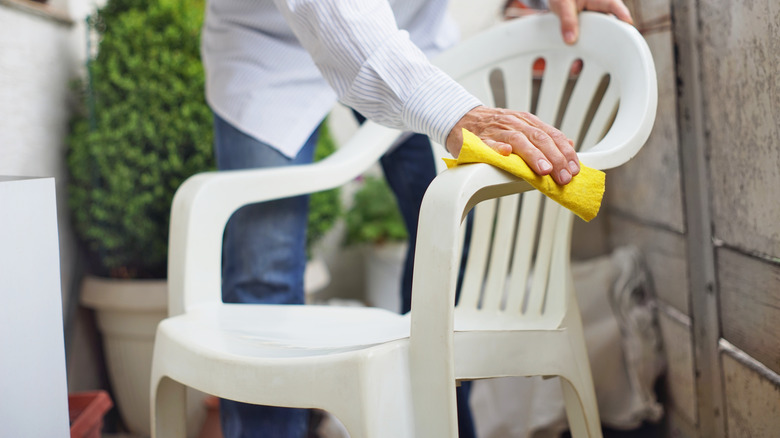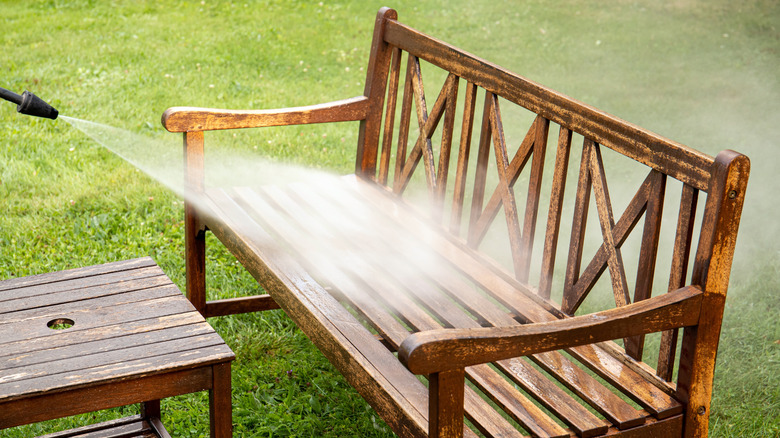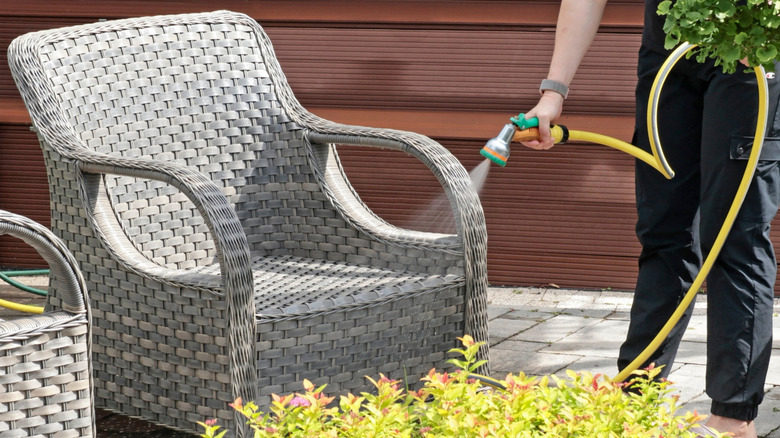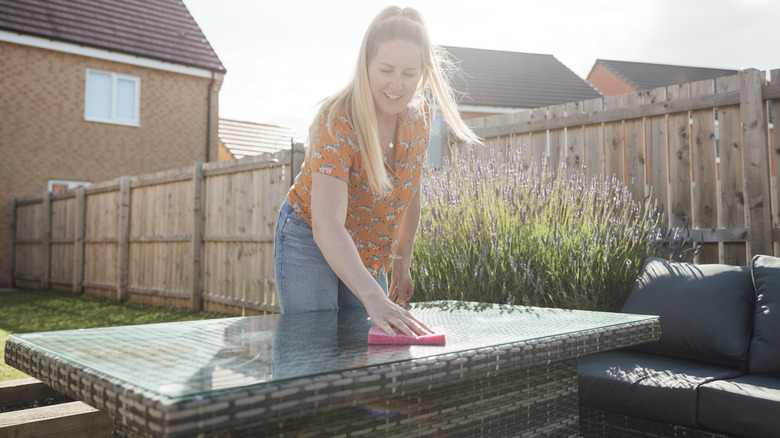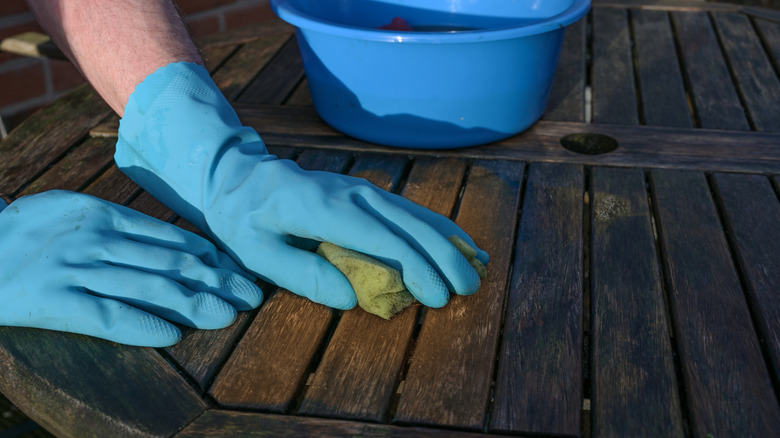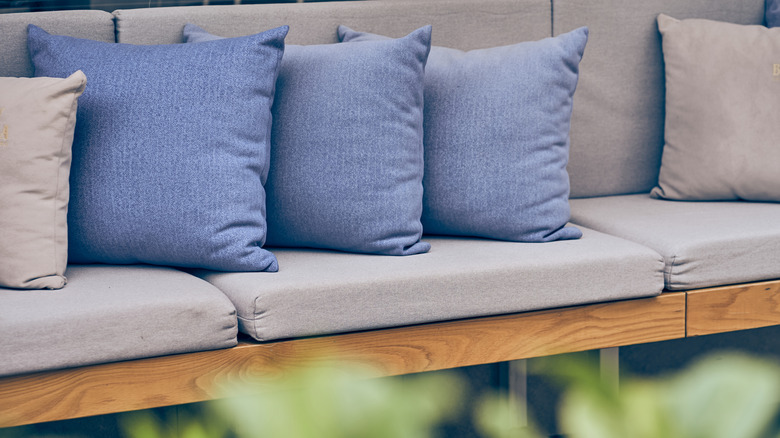Outdoor Furniture Cleaning Mistakes To Avoid At All Costs
We may receive a commission on purchases made from links.
Outdoor furniture is essential when creating a comfortable space in which to relax or entertain family members or friends. Over time, however, dirt, sun exposure, and even bird droppings can leave your pieces looking tired and unappealing. Regular cleaning is a must when it comes to keeping the area inviting, as well as extending the overall lifespan of the furniture. Although washing, rinsing, and disinfecting outdoor furniture is important, there are a few cleaning mistakes that should be avoided at all costs. Cleaning the wrong way can actually harm furniture, affecting their durability and overall attractiveness.
In order to prevent accidentally ruining your outdoor furniture while trying to get it clean, there are a few common blunders to keep in mind. For example, while pressure washing furniture speeds up the cleaning process, it actually strips away protective finishes when used on wood. Additionally, using bleach on plastic is a no-no, as this harsh chemical eats away at the surface, leaving it brittle and oftentimes discolored. Another mistake homeowners tend to make is scrubbing their wicker furniture with a brush. This may loosen some dirt, but it will also cause the fibers to fray and break. To clean your outdoor furniture and keep it in the best shape, you'll want to avoid these disastrous techniques and use alternative cleaning methods we've listed below.
Using overly strong alkaline cleaners on metal furniture
When it comes to cleaning outdoor furniture made of metal, very strong alkaline cleaners, such as ammonia or TSP (trisodium phosphate), are a no-go. These chemical cleaners are used to cut through grease and grime, but they are too harsh for use on iron and aluminum furniture pieces. Highly alkaline substances are corrosive, so much so that they are often used in paint stripping products — you can even make a DIY paint stripper with ammonia. Thanks to this corrosive, paint-eroding action, with repeated use, strong alkaline cleaners can slowly break down protective coatings on metal furniture, dull the paint finish, and accelerate oxidation, which can cause pitting.
Instead of grabbing an alkaline cleaner, opt for some mild dish soap and some warm water, as this is the best way to clean metal furniture. Use this mixture and a soft sponge to remove dirt, food spills, and bird droppings from your pieces. If you don't have a sponge, a microfiber cloth will also work. Rinse and dry the metal after you've finished cleaning. If your metal outdoor furniture pieces are solidly constructed and in good condition, you can also consider pressure washing them. Pressure washing is probably one of the fastest ways to remove dirt and buildup on outdoor furniture, but the strong spray can damage delicate elements, so use this method with caution on less sturdy furniture pieces. However, a solid set of wrought iron chairs should hold up fine, unless there are areas of loosened paint (but this should probably be removed and addressed anyway).
If you come across any small rust spots, you can create a homemade rust remover by mixing lemon juice or vinegar with salt. The citric acid in lemon juice (or acetic acid in vinegar) breaks down the rust, and the salt acts as a gentle physical exfoliant. Apply the mixture to the rusted area and wait 20 minutes before gently scrubbing it away. If the rust has left exposed metal behind, you'll need to treat this and touch up the paint. If you're not sure where to start, here are some professional tips for painting wrought iron. Finally, if you're trying to clean off small dots of rust from a chrome item, you can also try rubbing the surface with some aluminum foil.
Cleaning wood furniture with a pressure washer
It's natural to want to use the fastest cleaning method to refresh your outdoor wood furniture so you can move on to the next seasonal task on your list; however, it's a mistake to quickly wash wood with a pressure washer. While this machine easily blasts away dirt, grass blades, and stuck-on food particles, it also strips away the wood's protective finish. Without that protective coating, the wood is susceptible to cracks, splinters, and rot. Over time, mold and mildew can also become a problem, and you may find the furniture needs replacing earlier than expected.
One of the best ways to clean wood furniture involves mild soap, warm water, and a lint-free cloth. Dip the cloth in the soapy water, wring it out, and use a little elbow grease to wipe down the furniture. In order to prevent moisture damage, it's also a good practice to immediately rinse the wood after each cleaning using a second cloth that has only been dampened with water. Go back over the area again, but this time with a dry cloth to soak up any moisture left behind.
If your outdoor timber furniture doesn't have any kind of protective finish, and you're working with raw wood that's been bleached by the sun or stained by mold over many seasons, you could consider using a pressure washer on it as a once off treatment to help you restore the piece — but only if you have experience wielding this dirt-busting piece of equipment. A pressure washer can effectively blast off the top layer of weathered and mildewed wood, giving you a fresh surface that can be sanded (to remove any raised hairs) and sealed. However, unless you exercise precise control and keep the nozzle moving, you can create pressure washing "scars." These are light-toned marks in the wood, that are very difficult to remove.
Removing stains from plastic patio furniture with bleach
Bleach works wonders as a stain remover on plenty of materials, but using pure bleach on plastic probably isn't a good idea. If your plastic outdoor furniture is plagued with a mark, smudge, or area of discoloration, we wouldn't recommend you reach for bleach. This harsh chemical can cause lasting damage, as it breaks down plastic surfaces, leaving them weak, brittle, and prone to cracking. And if your plastic furniture is a specific color, the bleach may also lighten it, leaving patchy areas of discoloration. Very dilute bleach solutions may carry less of a risk, but there are a few tricks to combat stains on plastic without using bleach at all.
One of the best ways to clean plastic furniture is the same as what we outlined for wood furniture — gentle soap, water, and a soft cloth. To lift stains from your patio furniture, try applying a little shaving cream (it contains cleaning agents like surfactants also found in soap) to the area, wait 5 minutes, and then scrub the plastic clean with an old toothbrush. Another option is to use vinegar and water, the former of which is a mild acid that can be particularly helpful for lifting rust stains. Alternatively, if you're dealing with stubborn marks and don't feel like testing out these DIY removal methods, you can also purchase a dedicated cleaner that's formulated for outdoor furniture, such as the CLR Brands Outdoor Furniture Cleaner, which reviewers say is great for lifting stains. Oxygen bleach is another compound that can be used to lift stains from plastic, and hydrogen peroxide is often used to help reverse yellow discolorations from UV exposure. Finally, if you have already used bleach on your plastic chairs and tables in the past — and notice that the surface has dulled or the color has faded, you can also try a restorative product, such as Rejuvenate Outdoor Color Restore. Alternatively, applying car polish could also help add some shine back to the surface of the plastic.
Washing wicker furniture with an abrasive brush
Abrasive brushes work on several outdoor furniture materials to remove stuck-on dirt and grime, but it is a mistake to use them on wicker. All forms of wicker, including rattan and synthetic resin, are woven together with delicate fibers that can be damaged by rough bristles. Scrubbing the furniture with an abrasive brush could result in frayed and unraveled fibers that are weak and less flexible. If the wicker has a protective coating, the tough bristles can also scratch or remove it, leaving the wicker susceptible to added wear and damage from excess moisture.
Here is one of the easiest ways to clean wicker furniture that will keep it strong and attractive for many seasons to come. Start by removing any dust and debris with the brush attachment on your vacuum. It's also safe to use a regular brush with soft bristles — just don't press too hard while you're cleaning. Once you've removed as much dirt and debris as you can, move on to washing the wicker with a mild soap and warm water solution. Dip a microfiber cloth in the cleaning solution, wring it out, and begin working your way from the top of the furniture piece to the bottom. Make sure you move in the direction of the weave. Go back over the wicker with a damp rag to rinse away any soap residue before drying the piece with a lint-free towel. To make the job go faster and help you get into all the crevices, you could also try using a cleaning mitt (these Microfiber Terry Weave Mitts from Amazon are non-abrasive and can be used on both wet and dry surfaces).
Tip: If you spot mold growth in the crevices add some vinegar to the water in a 1:4 ratio. The acetic acid in vinegar can help kill off the mold spores. Stronger concentrations are more effective, but straight vinegar can also damage varnish and wood finishes, so we wouldn't recommend it on wicker items.
Not cleaning the furniture often enough
Another mistake to avoid when it comes to outdoor furniture is not cleaning pieces often enough. Neglecting this chore allows pollen, yard debris, and moisture to sit on the surface of the furniture for an extended period of time. Rust can begin to form on metal furniture pieces, and mold or mildew may start to grow on wood, wicker, or fabric cushions. Dirt also becomes stuck to the furniture when left to sit, hardening and making it more difficult to remove later on. Failing to regularly clean outdoor furniture can shorten its lifespan, costing you more money in the long run.
Start each season with a deep clean of all of your outdoor furniture pieces. Afterward, schedule regular washing and routine maintenance checks to ensure your pieces remain in tip-top shape. Always address any dirt, spills, or stains as soon as you notice them, and make it a habit to wipe down the furniture after exposure to a storm or heavy pollen.
Using too much water and cleaner when washing wood furniture
While you may be using the correct soapy water solution or cleaning product on your wood furniture, it's a mistake to use too much of it. Wood is actually quite porous, which means it is able to absorb moisture. When timber furniture is exposed to too much moisture, the wood can swell and warp. Over time, you may notice the wood begin to crack or even become misshapen. Excess moisture also leaves the wood susceptible to mold and mildew growth, as well as rot. When caring for your outdoor furniture, you'll need to keep moisture exposure to a minimum.
Instead of applying soapy water solutions or liquid cleaning products directly to your wood furniture pieces, apply using a microfiber cloth. You can also dunk the cloth in soapy water, then wring it out, and use the cloth to clean the wood. This is the best way to control how much liquid the wood is exposed to. Once you've finished wiping away all the dirt and grime, wet a clean microfiber cloth and wring it out. Use this rag to rinse off any remaining soap or cleaning solution residue. Dry the wood furniture with a third clean microfiber cloth to wick away any leftover moisture.
Not checking the product care label on your outdoor cushions
Outdoor patio sofa and chair cushions also need attention, but it is a huge mistake to wash them without first checking the product care labels. The material used to construct your outdoor cushions will vary, and so will the cleaning instructions. Neglecting to review the product care label can result in discoloration or shrinkage of the cushion covers. Using the wrong cleaning techniques can also weaken the fabric or strip away any protective coatings. Replacing cushions that have been ruined in the wash can be quite costly, so make sure you take the time to review product care labels before cleaning.
Some cushion covers are safe to remove and toss in a washing machine. These covers will have washing instructions, such as machine wash using cold water and tumble dry on low heat. Others may need to be spot cleaned by hand using a mild dish soap and water. To clean patio cushions that don't have a zipper, you can vacuum them with an upholstery attachment and, if the care labels allows, wash them by hand.
